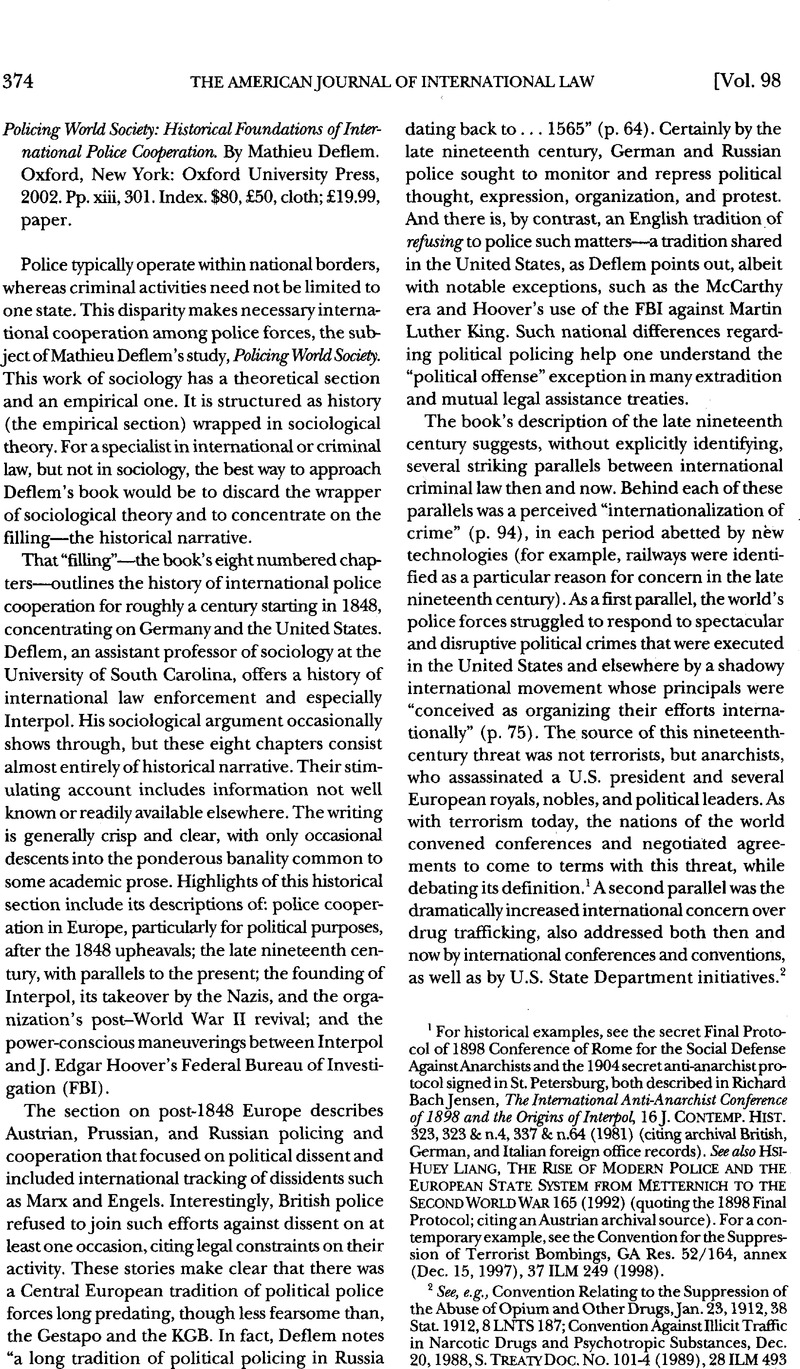No CrossRef data available.
Article contents
Policing World Society: Historical Foundations of International Police Cooperation. By Mathieu Deflem. Oxford, New York: Oxford University Press, 2002. Pp. xiii, 301. Index. $80, £50, cloth; £19.99, paper.
Published online by Cambridge University Press: 27 February 2017
Abstract

- Type
- Recent Books on International Law
- Information
- Copyright
- Copyright © American Society of International Law 2004
References
1 For historical examples, see the secret Final Protocol of 1898 Conference of Rome for the Social Defense Against Anarchists and the 1904 secret anti-anarchist protocol signed in St. Petersburg, both described in Richard, Bach Jensen, The International Anti-Anarchist Conference of 1898 and the Origins of Interpol, 16 J. Contemp. Hist. 323,323 & n.4, 337 & n.64 (1981)Google Scholar (citing archival British, German, and Italian foreign office records). See also Liang, Hsihuey, The Rise of Modern Police and The European State System from Metternich to the Second World War 165 (1992)Google Scholar (quoting the 1898 Final Protocol; citing an Austrian archival source). For a contemporary example, see the Convention for the Suppression of Terrorist Bombings, GA Res. 52/164, annex (Dec. 15,1997), 37 ILM 249 (1998).
2 See, e.g., Convention Relating to the Suppression of the Abuse of Opium and Other Drugs Jan. 23,1912,38 Stat 1912,8 LNTS187; Convention Against Illicit Traffic in Narcotic Drugs and Psychotropic Substances, Dec. 20,1988, S. Treaty Doc. No. 101-4 (1989), 28 ILM 493 (1989). An opium commissioner was appointed at the U.S. State Department in response to the earlier threat, and the State Department’s Bureau for International Narcotics and Law Enforcement Affairs was established in response to the latter.
3 See, e.g., Agreement for the Suppression of the White Slave Traffic, May 18,1904, 35 Stat. 1979, 1 LNTS 83; Protocol to Prevent, Suppress and Punish Trafficking in Persons, Especially Women and Children, Nov. 2,2000, UN Doc. A/55/383, at 53, 40 ILM 377 (2001)
4 Deflem notes that Interpol is much discussed but little understood, and that the writing about its history is often “either informed but uncritical or critical but uninformed” (p. 125). The sources that would be most useful for bringing this history more close to the present seem to be either published by Interpol itself, e.g., International Criminal Police Organization, Interpol: 75 Years Of International Police Co-Operation (1998)Google ScholarPubMed, or not in English, e.g., Greilsamer, Laurent, Interpol: Policiers Sans Frontieres (1997)Google Scholar.
5 In feet, the comment argues not against international law approaches, but against proposed efforts to achieve “unification” of various countries’ national criminal laws. Its author considered such efforts a waste of time, outside of limited areas such as extradition. Arthur, K. Kuhn, International Coöperation in the Suppression of Crimes, 28 AJIL 541 (1934)Google Scholar (editorial comment).
6 Thomas, L. Friedman, The New Math, N.Y. Times, Jan. 15, 2003, at A21 Google Scholar.
7 See U.S. Department of State, Trafficking in Persons Report (June 2003), at <http://www.state.gov>.
8 Note, Executive Discretion in Extradition, 62 Colum. L. Rev. 1313, 1313 n.l (1962)Google Scholar.
9 U.S. Department of State, Report on Extradition Policy & Practice, aggregate list, at 3 (submitted to House Committee on International Relations and Senate Foreign Relations Committee, May 6,2003) (on file with author).
10 Report on Extradition Policy & Practice, at 1-2.




